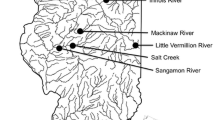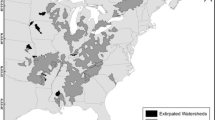Abstract
The basic biologies and ecologies of most freshwater fishes throughout the world are poorly understood. But such knowledge may be critical for conservation decisions. The redfin darter (Etheostoma whipplei), a poorly understood fish species, is an excellent model for highlighting this situation. Much of the limited range of this species is experiencing nontraditional natural gas extraction activities including hydraulic fracturing, which may be a significant source of silt input for streams. We investigated aspects of the ecology and metrics of reproductive success of redfin darters in central Arkansas. We examined habitat occupation through quantitative surveys of fish assemblages and habitat variables, and reproductive life history through field and laboratory surveys in Cypress Creek, Arkansas. We also examined the proportion of young fishes in populations relative to intensity of natural gas extraction activity. Ordination analysis found habitat gradients relating primarily to stream size. Redfin darters had the highest relative abundance in samples in small, high gradient streams. Redfin darters reproduce in the spring, peaking with the rainy season, using larger substrate than their close relatives. Reproductive success appears to be negatively related to natural gas extraction intensity. Redfin darters reproduce at both a time and in a habitat which may be especially susceptible to siltation from natural gas extraction activities, which may be reflected in fewer young fishes in populations. Our research highlights the importance of life history data in understanding responses to novel disturbances in freshwater fishes.






Similar content being viewed by others
References
Allan JD, Castillo MM (2009) Stream ecology: structure and function of running waters. Springer, Dordrecht
Balon EK (1975) Reproductive guilds of fishes: a proposal and definition. J Fish Res Board Canada 32:821–864
Barbour MT, Gerritsen J, Snyder D, Stribling JB (1999) Rapid bioassessment protocols for use in streams and wadeable rivers: periphyton, benthic macroinvertebrates and fish, 2nd edn. EPA 841-B-99-002. U.S. Environmental Protection Agency; Office of Water, Washington, DC
Berkman HE, Rabeni CF (1987) Effect of siltation on stream fish communities. Environ Biol Fishe 18:285–294
Blair AP (1959) Distribution of the darters (Percidae, Etheostomatinae) of northeastern Oklahoma. Southwest Nat 4:1–13
Boschung HT, Mayden RL (2004) Fishes of Alabama. Smithsonian Books, Italy
Burkhead NM, Jelks HL (2001) Effects of suspended sediment on the reproductive success of the Tricolor Shiner, a crevice-spawning minnow. Trans Am Fish Soc 130:959–968
Church M (2002) Geomorphic thresholds in riverine landscapes. Freshw Biol 4:541–557
Cross FB (1967) Handbook of fishes in Kansas. Kansas Museum of Natural History. University of Kansas, KS
Cross FB, Moore GA (1952) The fishes of the Poteau River, Oklahoma and Arkansas. Am Midl Nat 47:396–412
Cummings KS, Grady JM, Burr BM (1984) The life history of the mud darter, Etheostoma asprigene, in lake Creek, Illinois. Ill Nat Hist Surv Biol Notes 122:1–16
Davis WN, Bramblett RG, Zale AV (2010) Effects of coalbed natural gas development on fish assemblages in tributary streams of the Powder and Tongue rivers. Freshw Biol 55:2612–2625
Dodds WK, Gido K, Whiles MR, Fritz KM, Matthews WJ (2004) Life on the edge: the ecology of Great Plains prairie streams. Bioscience 54:205–216
Dudgeon D, Arthington AH, Gessner MO, Kawabata Z, Knowler DJ, Lévêque C et al (2006) Freshwater biodiversity: importance, threats, status and conservation challenges. Biol Rev 81:163–182
Entrekin S, Evans-White M, Johnson B, Hagenbuch E (2011) Rapid expansion of natural gas development poses a threat to surface waters. Front Ecol Environ 9:503–511
Forbes SA, Richardson RE (1920) The Fishes of Illinois. Illinois Natural History Survey, Urbana
Fry J, Xian G, Jin S, Dewitz J, Homer C, Yang L, Barnes C, Herlod N, Wickham J (2011) Completion of the 2006 national land cover database for the conterminous United States. Photogramm Eng Remote Sens 77:858–864
Harrison IJ, Stiassny ML (1999) The quiet crisis: a preliminary listing of freshwater fishes of the world that are extinct or “missing in action.”. In: MachPhee RDE, Sues HD (eds) Extinctions in near time: causes, contexts, and consequences. Kluwer, New York
Heins DC, Baker JA (1989) Growth, population structure, and reproduction of the percid fish Percina vigil. Copeia 1989:727–736
Heins DC, Machado DM (1993) Spawning season, clutch characteristics, sexual dimorphism and sex ratio in the redfin darter Etheostoma whipplei. Am Midl Nat 129:161–171
Heins DC, Baker JA, Tylicki DJ (1996) Reproductive season, clutch size and egg size of the rainbow darter, Etheostoma caeruleum, from the Homochitto River, Mississippi, with an evaluation of data from the literature. Copeia: 1005–1010
Hubbs CL, Black JD (1941) The subspecies of the American percid fish, Poecilicthys whipplii. Occas Pap Mus Zool Univ Mich 429:1–27
IUCN (2013) The IUCN red list of threatened species 2013.1. International Union for Conservation of Nature and Natural Resources http://www.iucnredlist.org. Accessed 10 June 2013
Jelks HL, Walsh SJ, Burkhead NM, Contreras-Balderas S, Diaz-Pardo E, Hendrickson DA et al (2008) Conservation status of imperiled North American freshwater and diadromous fishes. Fisheries 33:372–407
Karr JR (1981) Assessment of biotic integrity using fish communities. Fisheries 6:21–27
Karr JR, Fausch KD, Angermeier PL, Yan PR, Schlosser IJ (1986) Assessing biological integrity in running waters: a method and its rationale, vol 5. Ill Nat Hist Surv Special Publication, Champaign
Kuehne R, Barbour R (1983) The American Darters. The University Press of Kentucky, Springfield
Lindsay HL, Randolph JC, Carroll J (1983) Updated survey of the fishes of the Poteau River, Oklahoma and Arkansas. Proc Oklahoma Acad Sci 63:42–48
Maitland PS (1995) The conservation of freshwater fish: past and present experience. Biol Conserv 72:259–270
McCune B, Grace JB (2002) Analysis of ecological communities. MjM Software Design, Gleneden Beach
Miller RJ, Robison HW (2004) Fishes of Oklahoma. University of Oklahoma Press, Norman
Moore GA, Rigney CC (1952) Taxonomic status of the percid fish Poecilicthys radiosus in Oklahoma and Arkansas, with the description of two new subspecies. Copeia 1952:7–15
Nelson JS (2006) Fishes of the World. Wiley, Hoboken
Page LM (1983) Handbook of Darters. TFH Publications Inc, Neptune
Page LM, Burr BM (1991) Peterson field guide to freshwater fishes of North America north of Mexico, 1st edn. Houghton Mifflin Co, New York
Page LM, Burr BM (2011) Peterson field guide to freshwater fishes of North America north of Mexico, 2nd edn. Houghton Mifflin Co, New York
Page LM, Simon TP (1988) Observations on the reproductive behavior and eggs of four species of darters, with comments on Etheostoma tippecanoe and E. camurum. Trans Ill Acad Sci 81:205–210
Page LM, Smith PW (1971) The life history of the slenderhead darter, Percina phoxocephala, in the Embarras River, Illinois. Ill Nat Hist Surv Biol Notes 74:1–14
Petty JT, Grossman GD (2004) Restricted movement by mottled sculpin (Pisces: Cottidae) in a southern Appalachian stream. Freshw Biol 49:631–645
Pflieger WL (1997) The Fishes of Missouri. Missouri Department of Conservation
Piller KR, Bart HL, Walser CA (2001) Morphological variation of the redfin darter, Etheostoma whipplei, with comments on the status of subspecific populations. Copeia 2001:802–807
Retzer ME, Page LM, Swofford DL (1986) Variation and systematics of Etheostoma whipplei, the redfin darter (Pisces: Percidae). Copeia 1986:631–641
Robison HW, Buchanan TM (1988) Fishes of Arkansas. University of Arkansas Press, Fayetteville
Ross ST, Brenneman WM, Slack WT, O’Connell MT, Peterson TL (2001) The Inland Fishes of Mississippi. University Press of Mississippi, Jackson
Scalet CG (1973) Reproduction of the orangebelly darter, Etheostoma radiosum cyanorum. Am Midl Nat 89:156–165
Scott MC (2006) Winners and losers among stream fishes in relation to land use legacies and urban development in the southeastern US. Biol Conserv 127:301–309
Seesock WE, Ramsey JS, Seesock FL (1978) Life and limitations of the coldwater darter (Etheostoma ditrema) in Glencoe Spring, Alabama. ASB Bull 25:56
Shepard TE, O’Neil PE, Harris SC, McGregor SW (1993) Effects of coalbed natural gas development on the water-quality and fish and benthic invertebrate communities of the Big Sandy Creek drainage system, Alabama. Alabama Geol Surv Bull C171, Tuscaloosa, Alabama
Smith PW (1979) The Fishes of Illinois. University of Illinois Press, Champaign
Sutherland AB (2005) Effects of excessive sedimentation on stress, growth and reproduction of two southern Appalachian minnows, Erimonx monachus and Cyprinella galactura. Dissertation, University of Georgia
Sutherland AB, Meyer JL (2007) Effects of increased suspended sediment on growth rate and gill condition of two southern Appalachian minnows. Environ Biol Fish 80:389–403
Suttkus RD, Thompson BA, Bart HL (1994) Two new darters, Percina (Cottogaster), from the southeastern United States, with a review of the subgenus. Occas Pap Tulane Univ Mus Nat Hist 4:1–46
United States Environmental Protection Agency, United States Geological Survey (2006) The national hydrography dataset plus. http://www.horizon-systems.com/NHDPlus/index.php. Accessed 1 May 2011
Williams HFL, Havens DL, Banks KE, Wachal DJ (2008) Field-based monitoring of sediment runoff from natural gas well sites in Denton County, Texas, USA. Environ Geol 55:1463–1471
Winemiller KO, Rose KA (1992) Patterns of life-history diversification in North American fishes: implications for population regulation. Can J Fish Aquat Sci 49:2196–2218
Winn HE (1953) Breeding habits of the percid fish Hadropterus copelandi in Michigan. Copeia 1953:26–30
Winn HE (1958a) Observations on the reproductive habits of darters (Pisces-Percidae). Am Midl Nat 59:190–212
Winn HE (1958b) Comparative reproductive behavior and ecology of fourteen species of darters (Pisces-Percidae). Ecol Monogr 28:155–191
Wood PJ, Armitage PD (1997) Biological effects of fine sediment in the lotic environment. Environ Manage 21:203–217
Zar JH (1999) Biostatistical analysis. Prentice Hall, Upper Saddle River
Acknowledgments
This work was funded by grants provided by the Arkansas Game and Fish Commission, United States Fish and Wildlife, and the University of Central Arkansas. We owe a great debt of gratitude to our collaborating agencies, the University of Arkansas, and The Nature Conservancy. S. Entrekin, M. Evans-White, B. Austin, N. Jensen, and J. Kelso were instrumental collaborators in the natural gas portion of this project. We wish to thank J. Larson, R. Walker, C. Johnson, and J. Christian for their dedicated time in the field and lab, and we extend our thanks to the many undergraduates and graduate students at the University of Central Arkansas who donated time in the field. Without their help, this project would not have reached its full potential. All sampling protocols were approved by an Institutional Animal Care and Use Committee (IACUC 09–007).
Author information
Authors and Affiliations
Corresponding author
Rights and permissions
About this article
Cite this article
Stearman, L.W., Adams, G. & Adams, R. Ecology of the redfin darter and a potential emerging threat to its habitat. Environ Biol Fish 98, 623–635 (2015). https://doi.org/10.1007/s10641-014-0300-5
Received:
Accepted:
Published:
Issue Date:
DOI: https://doi.org/10.1007/s10641-014-0300-5




